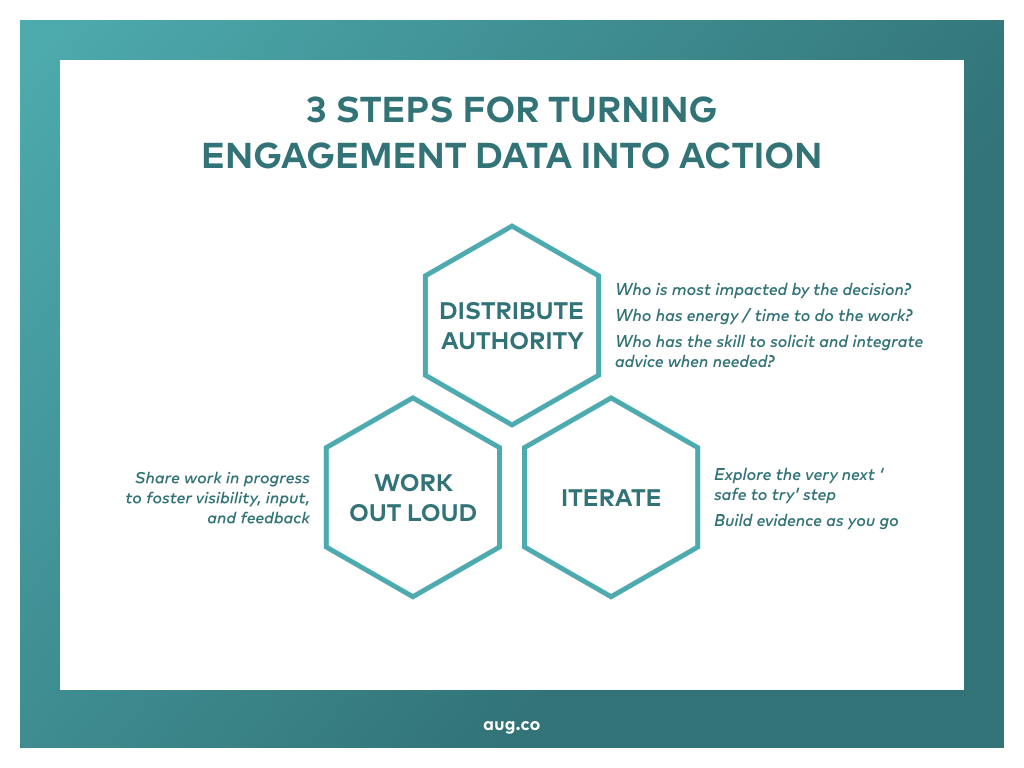Published March 8, 2019 | Updated August 14, 2024 | 3 minute read
Recently we visited an engagement survey company, and as they walked us through their dashboard, with its infinite ways to view results and analyze data, my brain froze around a few big questions.
Why is this so complex? What is it all for? What is the ultimate outcome? 100% engagement? When do you stop?
At this point, entirely disconnected from the presentation, I smiled wondering about what 100% engagement would look like. People running through an open plan office screaming “I NEVER WANT TO LEAVE THIS BUSINESS - I AM MY FULLEST TRUEST SELF HERE - ALL MY FRIENDS ARE HERE - I LOVE THIS COMPANY!” I mean, we all remember that infamous Steve Ballmer moment, right?
It’s obvious that the ultimate goal of an engagement survey isn’t a permanent frenzied state of workplace bliss. Because it doesn’t exist, and even if you could achieve it, it would be exhausting. So what is the goal behind this investment? Why do we continue to launch engagement surveys and hound teams annually, and increasingly quarterly, to “stop what you’re doing and tell me how you feel”? The point is to do something about it.
It seems simple enough, but many organizations are struggling with too much data and not enough action. Employees input their feelings into the magic box, and that data funnels up to some higher power, and if employees are lucky they might hear five minutes on it at the next all-hands meeting. The other common misstep is delegating the work to a “task force” without delegating any clear authority. A company we recently worked with took this approach. The executive team delegated the engagement survey work to an HR-led committee which then appointed a cross-functional working group to design the solutions. Now, the working group is designing solutions, with no idea who has the authority to say yes to their plans, or who is going to implement them. Talk about a morale killer.
There are bright spots, though. Ranked as #16 on Fortune’s 2019 Best Places to Work, Baird, a financial services firm, turned an employee question in a public Q&A into a new parental leave policy within ten weeks. Even Best Buy has managed to stay relevant in an Amazon world, in part because the CEO, who, after spending time in stores, prioritized fixing the broken systems that employees were complaining about. It’s also worth noting how in both these cases, leaders found other ways of understanding employee engagement outside of surveys. Inspired by these stories and the organizations we’ve worked with, here are three simple steps that will help you turn employee gripes into action.
1. Give others clear authority to implement changes.
Instead of defaulting to the usual suspects for taking on this work, consider expertise and experience alongside these questions:
- Who has the best access to data/info?
- Who is most impacted by the decision?
- Who has energy/time to do the work?
- Who has the skill to solicit and integrate advice when needed?
2. Take an iterative approach.
Rather than spending months or even years trying to come up with a perfect solution, encourage the team to explore the very next ‘safe to try’ step that would move us in the right direction. This is a great way to build evidence for a particular change while not making any decisions that feel too big to reverse.
3. Work out loud.
The truth is that the ‘grand reveal’ approach slows us down. Instead, sharing work in progress fosters visibility, input, and feedback on the work being done so that teams can quickly adapt to new circumstances and changing information.

If you follow these steps you will make better, faster progress. And beyond this benefit, taking this approach to addressing engagement will make employees feel heard and included. It might even make them feel more engaged.
A final word of advice that you won't find in your engagement survey dashboard—it might get worse before it gets better. We saw this in one large consumer packaged goods company—when people realize it is possible to work in a new way, it makes them look more critically at the broader organization. To be successful, you have to commit to learning through the change and stay focused on the long term, which means setting smaller incremental goals. And as a side benefit, when the next survey comes around, there really will be something to write in about.








